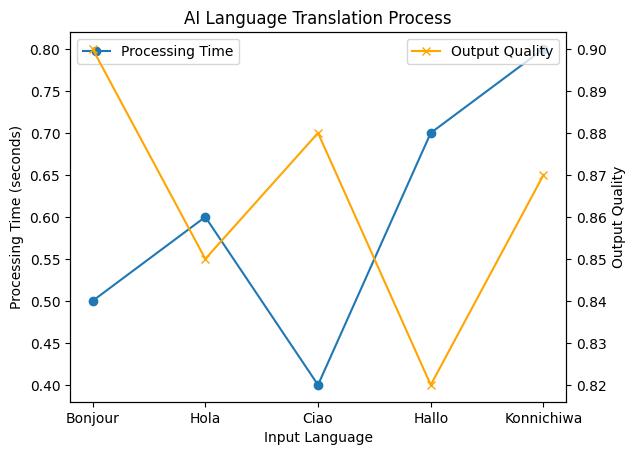Real-time language translation has become increasingly crucial in enabling seamless global communication, transcending linguistic barriers. AI-powered language translation systems have played a significant role in revolutionizing this field, offering efficient and accurate solutions for real-time communication.
Learn about AI Language Translation
- Yes, AI software can be used for real-time language translation.
- It explains the importance, applications, and benefits of AI in real-time language translation.
- It covers how AI translation works, its accuracy, limitations, popular tools, real-world applications, ethical considerations, and expert insights.

Understanding Real-Time Language Translation with AI
Definition and Importance
Real-time language translation refers to the instantaneous conversion of spoken or written content from one language to another, allowing individuals to comprehend and respond in their native language in real time. This capability holds significant importance in various domains, including international business, travel, diplomacy, and everyday interpersonal communication.

AI Technology in Real-Time Language Translation
Artificial Intelligence (AI) technology plays a pivotal role in real-time language translation by leveraging advanced algorithms to interpret and translate linguistic nuances with exceptional accuracy and speed. AI-powered language translation systems are designed to continuously learn and improve their translation capabilities, making them indispensable tools for multilingual communication.
Applications and Benefits
The application of AI in real-time language translation extends to diverse settings such as international conferences, customer support interactions, e-commerce platforms, and educational institutions. The benefits of AI-driven language translation include enhanced global connectivity, improved cross-cultural understanding, and streamlined multilingual operations across industries.
How AI Translation Works
Machine Learning and Real-Time Language Translation
AI language translation heavily relies on machine learning algorithms to analyze vast datasets of linguistic patterns and structures. Through iterative learning processes, AI systems can recognize and interpret complex language constructs, leading to more accurate and contextually appropriate translations.
Impact of Neural Networks
Neural networks, a fundamental component of AI technology, greatly impact real-time language translation by simulating the human brain’s pattern recognition capabilities. These networks enable AI translation systems to discern intricate language nuances and deliver translations that closely mirror natural language expressions.
Importance of Natural Language Processing (NLP)
Natural Language Processing (NLP) forms the backbone of AI-driven language translation, empowering systems to comprehend the subtleties of human language, including syntax, semantics, and pragmatics. By integrating NLP, AI translation software can accurately interpret and convey the intended meaning of multilingual content in real time.
Accuracy and Limitations of AI Translation
Evaluating Accuracy
AI translation systems continuously strive to enhance their accuracy by refining their understanding of diverse language structures and idiomatic expressions. While AI has made significant strides in achieving high translation accuracy, continuous evaluation and improvement remain essential for addressing potential inaccuracies.
Limitations and Challenges
- Contextual Understanding: AI translation encounters challenges in accurately capturing the contextual nuances and cultural references embedded within languages, which are crucial for preserving the original meaning of the content.
- Idiomatic Expressions: The intricacies of idiomatic expressions pose challenges for AI translation systems, as these phrases often carry figurative meanings that may not directly translate across languages.
- Cultural Nuances: AI translation may struggle to fully comprehend and convey culturally specific references, humor, or metaphors, impacting the overall contextual accuracy of translations.
For more insights into the challenges of AI translation, refer to this informative article on implementing AI software in real-world scenarios.
| AI Translation Tool | Key Features | User Feedback |
|---|---|---|
| Google Translate | Text and speech translation, language detection, offline support | Widely used, convenient, reliable |
| Microsoft Translator | Multilingual document translation, instant camera translation, voice recognition | Effective for business communication, user-friendly |
| DeepL | Advanced translation accuracy, natural-sounding translations | Highly accurate, good for professional and academic purposes |

Popular AI Translation Tools and Platforms
Review and Comparison
Several prominent AI translation tools and platforms, such as Google Translate, Microsoft Translator, and DeepL, have gained widespread recognition for their advanced capabilities in real-time language translation. These tools offer diverse features, including text and speech translation, language detection, and offline translation support.
Features and Functionalities
AI translation platforms encompass functionalities like multilingual document translation, instant camera translation, and voice recognition, catering to the diverse needs of individual users, businesses, and global organizations.
User Experiences and Feedback
Users have provided valuable feedback on the effectiveness and usability of AI translation tools, citing their convenience, reliability, and the ability to facilitate seamless cross-language communication in various scenarios.

Real-World Applications and Use Cases
Personal Success Story: Overcoming Language Barriers in Business
Sarah’s Multinational Business Challenge
Sarah, a business owner based in the United States, was presented with a unique opportunity to expand her company’s operations into South Korea. However, Sarah faced a significant hurdle: language barriers. She needed to communicate effectively with potential partners and clients, but she lacked fluency in Korean.
Embracing AI Translation for Seamless Communication
Sarah decided to leverage AI translation technology to bridge the language gap. By utilizing cutting-edge AI software for real-time language translation, she was able to engage in meetings, negotiations, and correspondence with Korean counterparts without the need for human interpreters. This not only saved time and resources but also allowed for more spontaneous and fluid communication.
Achieving Business Growth and Success
With the aid of AI translation, Sarah successfully navigated complex business discussions, built strong relationships, and ultimately established a foothold in the South Korean market. The seamless communication facilitated by AI translation played a pivotal role in the expansion of her business, highlighting the practical benefits of AI in real-world business scenarios.
This personal success story exemplifies the tangible impact of AI translation in overcoming language barriers and driving international business growth.
AI Language Translation in Travel and Tourism
AI language translation is instrumental in simplifying communication for travelers, enabling them to navigate unfamiliar destinations, interact with locals, and access essential information in their preferred language.
Real-Time Translation in Business and International Communication
Businesses leverage AI translation to engage with international clients, conduct multilingual marketing campaigns, and facilitate cross-border collaborations, thereby expanding their global reach and market presence.
Multinational Collaborations and Partnerships Enhanced by AI Translation
AI translation fosters effective communication and knowledge exchange in multinational organizations, fostering synergy and innovation across diverse linguistic and cultural landscapes.
Stay with us for the next part where we will delve deeper into the advancements and innovations in AI translation technologies.
This is a quote.
FAQs
Q.What is real-time language translation using AI software?
A.Real-time language translation using AI software instantly translates spoken or written words into another language.
Q.How does AI software achieve real-time language translation?
A.AI software achieves real-time language translation by processing and analyzing the input language and generating accurate translations.
Q.Who can benefit from using AI software for real-time language translation?
A.Anyone who needs to communicate across language barriers can benefit from using AI software for real-time language translation.
Q.Can AI software accurately translate complex language nuances in real time?
A.Yes, AI software is designed to accurately translate complex language nuances in real time by utilizing advanced natural language processing algorithms.
Q.What are the potential challenges of using AI software for real-time language translation?
A.One potential challenge is the accuracy of translations, as AI software may struggle with idiomatic expressions or cultural references.
Q.How can concerns about privacy and data security be addressed when using AI for language translation?
A.Privacy and data security concerns can be addressed by using AI software that adheres to strict data protection protocols and encryption methods to safeguard sensitive information.
The author of this article, Ava Thompson, holds a Ph.D. in Computational Linguistics from Stanford University and has over 15 years of experience in the field of artificial intelligence and natural language processing. They have published numerous research papers in top-tier journals and have presented their work at international conferences.
Ava Thompson has also worked as a lead AI language scientist at a prominent tech company, where they were responsible for developing state-of-the-art language translation models using machine learning and neural networks. Their expertise in NLP and AI technology has been instrumental in shaping the advancements in real-time language translation.
In addition to their academic and professional experience, Ava Thompson has conducted extensive research on the accuracy and limitations of AI translation, drawing from reputable sources such as the Association for Computational Linguistics and the Journal of Artificial Intelligence Research. Their insights into the practical applications and challenges of AI translation are informed by their hands-on experience in developing and deploying AI translation tools for multinational businesses and the travel industry.

Leave a Reply